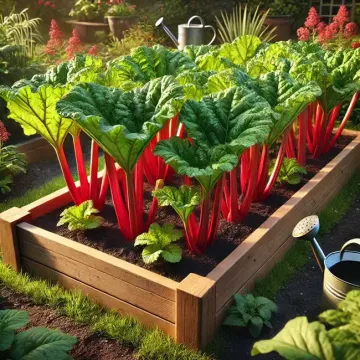Rhubarb, a hardy perennial vegetable with vibrant red stalks and large, heart-shaped leaves, is a beloved plant in many home gardens. Known for its tart flavor, rhubarb is a popular ingredient in pies, jams, and sauces. Although often mistaken for a fruit due to its culinary uses, rhubarb is technically a vegetable. This article explores the history of rhubarb, its benefits, and tips for growing it in your home garden.
History of Rhubarb
Rhubarb has a long and storied history that traces back to ancient China, where it was initially grown for medicinal purposes. The Chinese valued rhubarb for its strong laxative properties, and it was used in traditional remedies for digestive issues. From there, rhubarb made its way to Europe along the Silk Road, where it became a prized commodity in the trade routes.
In the 18th century, rhubarb was introduced to North America, where it quickly gained popularity as a versatile culinary ingredient. Since then, it has become a staple in many gardens, especially in cooler climates where it thrives.
Benefits of Growing Rhubarb
Growing rhubarb in your garden offers several benefits:
- Perennial Growth: Rhubarb is a perennial plant, which means that once established, it will return year after year, providing you with a consistent harvest with minimal effort.
- Low Maintenance: Rhubarb is relatively low maintenance and hardy, making it ideal for beginner gardeners. It can withstand cold temperatures and requires little attention once established.
- Nutrient-Rich: Rhubarb is a good source of vitamins C and K, fiber, and antioxidants, making it a healthy addition to your diet.
- Versatile Culinary Use: The tart flavor of rhubarb pairs well with sweet fruits like strawberries, making it a popular ingredient in pies, crisps, sauces, and even savory dishes.
Growing Rhubarb in Your Home Garden
Rhubarb is relatively easy to grow, provided you choose the right location and follow a few essential guidelines.
- Choosing a Location: Rhubarb plants prefer a location with full sun, although they can tolerate partial shade. Ensure that the soil is well-drained, as rhubarb does not like to sit in waterlogged conditions. Rich, fertile soil with plenty of organic matter is ideal.
- Planting Rhubarb: Rhubarb is typically planted in early spring when the ground is workable. You can start rhubarb from crowns or divisions of established plants. Dig a hole large enough to accommodate the roots and plant the crown about 1-2 inches below the soil surface. Space plants about 3 feet apart to allow ample room for their large leaves to spread.
- Watering and Mulching: Rhubarb plants need consistent moisture, especially during the growing season. Water them regularly, particularly in dry spells. Mulching around the plants with organic matter like straw or compost helps retain moisture and suppress weeds.
- Fertilizing: Rhubarb is a heavy feeder, so it's important to provide it with adequate nutrients. Apply a balanced fertilizer or compost in the spring as the plant starts to grow. Additional feedings throughout the growing season can help promote healthy growth.
- Harvesting Rhubarb: Rhubarb can be harvested in its second year of growth. Only pick stalks that are at least 10-15 inches long, and leave at least one-third of the stalks on the plant to ensure it continues to grow vigorously. Harvest by gently pulling the stalks from the base or cutting them with a sharp knife. Avoid eating the leaves, as they contain oxalic acid and are toxic.
- Winter Care: Rhubarb is frost-hardy and can survive harsh winters. In colder climates, it’s a good idea to apply a layer of mulch over the crown to protect it from extreme cold.
Common Problems and Pests
Rhubarb is relatively pest and disease-resistant. However, it can occasionally suffer from crown rot if planted in poorly drained soil. To avoid this, ensure the soil drains well and avoid overwatering. Slugs and snails may also target young plants, so be vigilant and use organic slug repellents if necessary.
Popular Varieties of Rhubarb
There are several varieties of rhubarb to choose from, each with slightly different characteristics:
- Victoria: A classic variety known for its large, greenish-red stalks and reliable productivity.
- Canada Red: This variety produces deep red stalks that are sweet and tender.
- Valentine: Known for its bright red color and sweeter flavor, making it a favorite for desserts.
Culinary Uses of Rhubarb
Rhubarb is most commonly used in sweet desserts like pies, tarts, and crumbles. Its tartness pairs well with sugar and fruits like strawberries and apples. Rhubarb can also be used in savory dishes, adding a unique flavor to sauces, chutneys, and marinades. It is often stewed with sugar to make a delicious compote that can be served over yogurt, pancakes, or ice cream.
Rhubarb is a delightful addition to any home garden, providing vibrant color, easy maintenance, and a bounty of delicious stalks year after year. With proper care and attention, rhubarb will reward you with years of tasty harvests, making it a versatile and beneficial plant for both novice and experienced gardeners alike.

